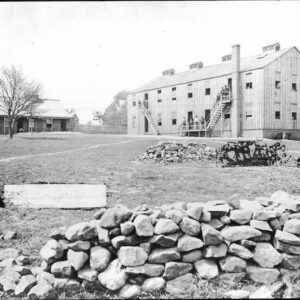Tag: Fort Hamilton (Brooklyn NY)
Wikipedia says: Fort Hamilton is a United States Army installation in the southwestern corner of the New York City borough of Brooklyn, surrounded by the communities of Bay Ridge and Dyker Heights. It is one of several posts that are part of the region which is headquartered by the Military District of Washington. Its mission is to provide the New York metropolitan area with military installation support for the Army National Guard and the United States Army Reserve. The original fort was completed in 1831, with major additions made in the 1870s and 1900s. However, all defenses except about half of the original fort have been demolished or buried.
On July 4, 1776, a small American battery (the Narrows Fort) on the site of today’s Fort Hamilton (the east side of the Narrows) fired into one of the British men-of-war convoying troops to suppress the American Revolution. HMS Asia suffered damage and casualties, but opposition to the immense fleet could be little more than symbolic. However, this very significant event marked one of the earliest uses of the site for military purposes.
The War of 1812 underscored the importance of coastal defense (since the British burned parts of Washington, DC) and helped to promote a new round of fort building. The new forts, including Fort Hamilton, were eventually termed the third system of US seacoast forts. The cornerstone for Fort Hamilton was set in place by its designer, Simon Bernard, on June 11, 1825. Bernard was previously a French military engineer under Napoleon, who had joined the US Army after Napoleon’s defeat in 1815. Six years and a half million dollars later, the fort was ready to receive its garrison, initially Battery F of the 4th US Artillery.
Fort Hamilton (now the Casemate Fort, Whiting Quadrangle) was designed primarily as a landward defense for Fort Lafayette, although it had a sea-facing front as well. Fort Lafayette was offshore on Hendricks Reef, and was demolished in the 1960s to make room for the eastern tower of the Verrazzano-Narrows Bridge. Fort Hamilton was in the shape of a trapezoid, with the wide side facing the Narrows and the narrow side facing inland. It had two tiers of cannon all around: a casemated tier inside the fort and a barbette tier on the roof. Loopholes for muskets were provided on the three landward sides. A dry ditch also protected these three sides. A caponier, a rare feature in US forts, projected into the ditch to defend it against attack. Two smaller caponiers enclosed the ends of the ditch, projecting off the seacoast front. The fort’s sally port was in the middle of this front. A square redoubt with its own ditch was located behind the fort to provide an initial landward defense position.
Though references to the structure as Fort Hamilton occur as early as 1826, it was not officially named for the former Senior Officer of the United States Army and first Secretary of the Treasury, Alexander Hamilton, until the twentieth century. In 1839 the Federal government gave permission to New York State’s 27th Regiment to drill at the fort, thus qualifying it as the nation’s first National Guard training camp. The following year, it allocated $20,000 to improve the fort’s armaments, and Captain Robert E. Lee, then an officer of the Army Corps of Engineers, was assigned the task of improving the defenses of the fort as well as those of other military installations in the area. Lee served as Fort Hamilton’s post engineer from 1841 to 1846 and is credited with the initial design of several subsequent New York-area forts, notably the rebuilt Fort Richmond and Fort Tompkins, along with the Fort at Willets Point and the Fort at Sandy Hook. Lieutenant Thomas “Stonewall” Jackson also served at Fort Hamilton, and Captain Abner Doubleday served as the post commander in 1861, shortly after serving at Fort Sumter during the bombardment that started the Civil War.
Civil War
During the Civil War, Fort Hamilton’s garrison expanded. A ship barrier across the Narrows assisted Fort Hamilton and its sister forts on Staten Island, now called Fort Wadsworth, in protecting the harbor against the possibility of Confederate raiders. The forts also provided troops to help put down the New York Draft Riots of 1863. Fort Hamilton also served as a prisoner-of-war camp, and an exterior “New Battery” of guns was added.
Rifled cannon made vertical-walled masonry fortifications obsolete during the Civil War. The first response of the US coast defense forces to this was a series of new batteries, with guns in open positions behind low earth walls and brick magazines with heavy earth cover between the guns. Most of these were located near existing forts. In 1871 construction began at Fort Hamilton on an 8-gun water battery and a 15-gun mortar battery, but the latter was never completed or armed. Money for these projects ran out in the late 1870s, and US coast defense languished, with few improvements completed for nearly 20 years.
Showing all 5 resultsSorted by latest




